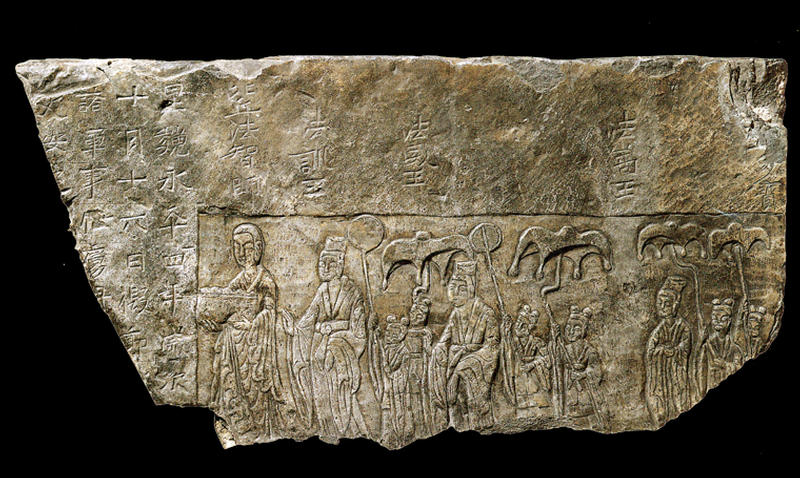供養人行列図断片
- 古陽洞
- 北魏時代
- 6c
- 石灰石
- H-23.7 W-46.7
- 所蔵
- 山口コレクション 大阪市立美術館蔵
石灰石/古陽洞 北魏時代・永平4年(511)/高23.7 cm 幅46.7 cm/
大阪市立美術館蔵(山口コレクション)
この浮彫は古陽洞の北壁の第2層、第2龕の菩薩交脚像龕の下部にあったもので、両手で大きな華篭を捧げる僧侶を先頭に、冠をかぶる王3人が表され、それぞれに傘や扇を捧げた従者2人が付き添っている。僧の上には「比丘法智師」、諸王の上には向かって左から「法訓王」「法威王」「法嵩[すう]王」の名が刻まれている。永平4年(511)10月16日、華[か]州[しゆう]刺[せき]史[し]であった安定王元燮が、今は無き祖先や親のためにこの菩薩交脚像の仏龕を開いたことを伝えている。古陽洞の第2充実期にあたる。
Catalogue Entry
Limestone/ Guyangdong Cave, Northern Wei dynasty, Yongping 4 (511)/
H. 23.7 cm; W. 46.7 cm/ Osaka Municipal Museum of Art, Yamaguchi Collection
This relief carving was located beneath the bodhisattva in crossed-ankle pose in the 2nd niche on the 2nd level of the north wall of the Guyangdong Cave. The procession is led by a priest holding a large flower basket with both hands, followed by three princes wearing crowns, and two attendants, carrying a parasol and fan respectively. The names of the figures are incised above, with the name "Biqiu Faxhishi" above the priest, and above the princes, from the left, "Faxungwang," "Faweiwang," and "Fasongwang." The inscription indicates, that on the 16th day of the 10th month of Yongping 4 (511), Prince Xie of Anding who had been Regional Inspector of Huazhou, ordered the carving of a sculptural niche with a Bodhisattva in crossed-ankle pose in memory of his deceased ancestors and parents. This sculpture dates from the 2nd period of activity at the Guyangdong Cave.
